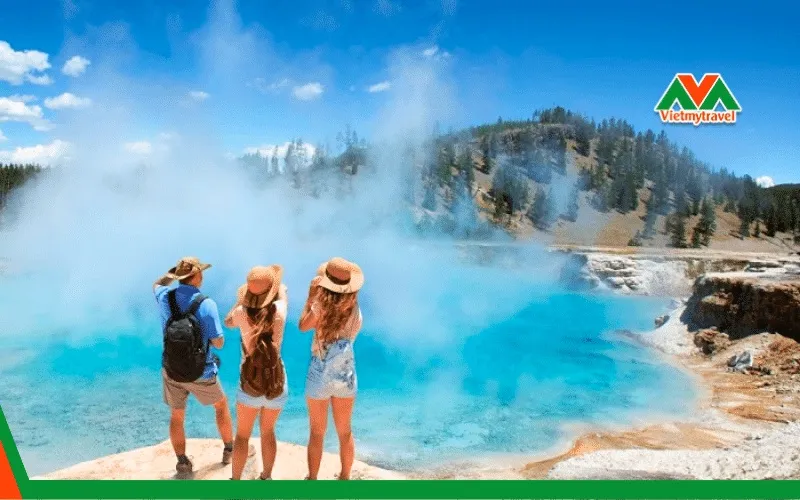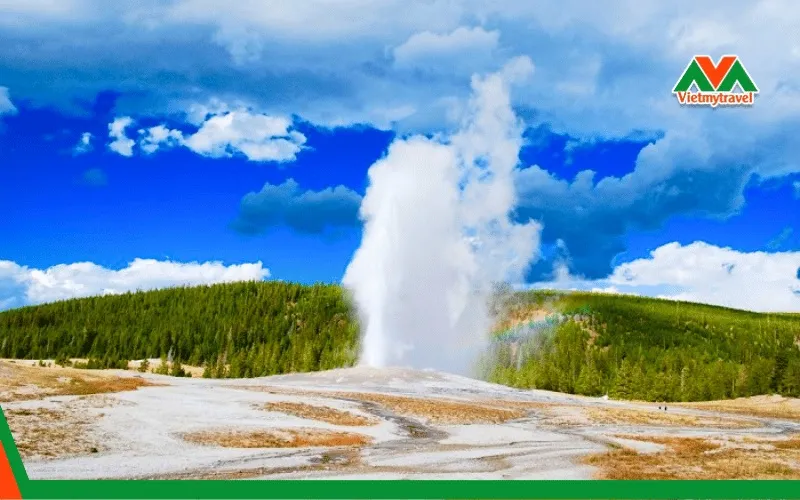Wyoming, a mountainous state in the western United States, has long been renowned as a pristine paradise with majestic and diverse landscapes. From the world-famous Yellowstone National Park and the magnificent Grand Teton National Park to the rolling mountains and vast prairies, Wyoming offers countless opportunities for photographers to unleash their creativity and capture breathtaking moments of nature. If you are a photography enthusiast eager to explore the wild beauty of the American West, this guide to photographing Wyoming’s wilderness will be your indispensable companion, helping you capture stunning shots and preserve unforgettable memories.
Wyoming is not only an attractive tourist destination but also an endless source of inspiration for those who love the art of photography. With diverse terrains, from primeval forests, clear blue lakes, and magnificent waterfalls to towering granite mountains, every corner of Wyoming holds unique and captivating beauty. This article will take you to discover the best photography spots in Wyoming, share useful photography tips, and help you prepare fully for a memorable photographic adventure.
Yellowstone – Nature’s Symphony of Colors
Yellowstone National Park, the first national park in the United States and the world, is one of the must-visit destinations when photographing Wyoming’s wilderness. This place is not only famous for its diverse system of hot springs and geysers but also boasts magnificent natural landscapes, from vast pine forests and lush meadows to majestic limestone canyons.
Ideal Times to Photograph Yellowstone
Summer (June to August) and autumn (September to October) are the best times to photograph Yellowstone. In summer, the weather is warm and pleasant, the vegetation is lush green, and wildlife is active. In autumn, Yellowstone puts on its brilliant golden coat of maple leaves, creating a romantic and poetic scene. However, if you want to experience the peaceful and tranquil beauty of Yellowstone, spring (April to May) and winter (November to March) are also interesting options. In spring, Yellowstone is filled with wildflowers, while in winter, the park is covered in white snow, creating a magical and unique setting.
Must-Visit Photography Locations in Yellowstone
- Grand Prismatic Spring: The largest hot spring in Yellowstone and the third largest in the world, Grand Prismatic Spring impresses visitors with its vibrant rainbow colors. To get the best panoramic photos, you should go to the Fairy Falls Trail Overlook or Grand Prismatic Overlook. The ideal time to photograph Grand Prismatic Spring is at noon on a sunny day, when sunlight shines directly onto the spring, highlighting the vivid colors of the water.

- Old Faithful Geyser: Yellowstone’s most famous geyser, Old Faithful Geyser, erupts regularly every 90 minutes, creating a towering column of hot water into the sky. To capture the impressive eruption moment, you should choose a favorable observation point around the Old Faithful Geyser Basin area and have your camera ready so you don’t miss any moment.

- Yellowstone Lake: The largest freshwater lake in North America, located at an altitude of over 2,000 meters above sea level, Yellowstone Lake is an ideal destination for photographing sunrise and sunset. The flat lake surface reflects the clear blue sky or golden-orange sunlight, creating a poetic and lyrical scene. You can rent kayaks or canoes to explore the lake and find unique shooting angles.
- Grand Canyon of the Yellowstone: The Grand Canyon of the Yellowstone is considered a geological wonder with towering cliffs, magnificent waterfalls, and the winding Yellowstone River. Artist Point and Inspiration Point viewpoints are ideal locations for you to admire the panoramic view of the canyon and capture impressive panorama photos.
- Lamar Valley: Dubbed the “Serengeti of North America,” Lamar Valley is home to a large concentration of wildlife such as bison, elk, wolves, and black bears. If you are passionate about wildlife photography, take the time to explore Lamar Valley at dawn or dusk, when animals are most active.
Grand Teton – The Majestic Beauty of Granite Mountains
Located just south of Yellowstone, Grand Teton National Park is a must-visit destination on your Wyoming wilderness photography journey. The majestic Teton Range with its sharp granite peaks rising into the clear blue sky, reflected in the flat surface of Jackson Lake, creates a magnificent and emotional scene.
Ideal Times to Photograph Grand Teton
Similar to Yellowstone, summer and autumn are the best times to photograph Grand Teton. Summer weather is warm and pleasant, suitable for trekking and exploring nature. In autumn, maple leaves turn golden red, creating a romantic and charming scene. If you want to photograph snow-covered Teton peaks, winter is a suitable time, but you need to prepare carefully for clothing and equipment to cope with harsh weather.
Must-Visit Photography Locations in Grand Teton
- Snake River Overlook: The iconic viewpoint of Grand Teton, Snake River Overlook is where Ansel Adams captured the classic photo “The Tetons and the Snake River.” From here, you can admire the panoramic view of the majestic Teton Range and the Snake River winding at the foot of the mountains. The ideal time to photograph at Snake River Overlook is in the early morning or late afternoon, when soft golden light highlights the beauty of the landscape.
- Schwabacher Landing: Another great spot for photographing sunrise and sunset at Grand Teton. Schwabacher Landing is a floodplain along the Snake River, where you can capture stunning reflection photos of the Teton Range on the flat water surface.
- Jenny Lake: A jade-green lake nestled at the foot of the Teton Mountains, Jenny Lake is an ideal destination for hiking and landscape photography. You can take a boat trip on the lake or trek around the lake to explore the best shooting angles. Inspiration Point and Hidden Falls viewpoints are must-visit locations when exploring Jenny Lake.
- Mormon Row: The historic Mormon Row farm area with its old wooden houses and the Teton Range as a backdrop is a unique photography spot with a strong American West feel. The ideal time to photograph Mormon Row is at dawn, when the morning sun shines through the wooden houses, creating a warm and romantic scene.

Tips for Effective Wyoming Wilderness Photography
To capture impressive and high-quality Wyoming wilderness photos, you need to equip yourself with the necessary knowledge and skills. Here are some useful photography tips you should refer to:
Prepare Appropriate Equipment
- Camera: DSLR or mirrorless cameras with full-frame or APS-C sensors are the best choices for landscape photography.
- Lenses: Wide-angle lenses (16-35mm) for capturing panoramic views, standard lenses (24-70mm) for versatile framing, and telephoto lenses (70-200mm or longer) for wildlife and distant details.
- Tripod: A sturdy tripod is indispensable for shooting long exposures, HDR photos, and sharp landscape photos.
- Filters: Polarizing filters (CPL) to reduce glare and increase contrast, neutral density filters (ND) for shooting long exposures, and graduated neutral density filters (GND) to balance exposure between the sky and the ground.
- Spare batteries and memory cards: Make sure you have enough batteries and memory cards so you don’t miss any beautiful moments.
- Camera bag: A dedicated camera bag helps protect your equipment from bumps, dust, and harsh weather.
Master Landscape Photography Techniques
- Composition: Apply basic composition rules such as the rule of thirds, leading lines, S-curves, foreground, middle ground, and background to create depth and appeal to the photo.
- Lighting: Take advantage of golden hour and blue hour light at dawn and dusk to get the best landscape photos. Pay attention to the direction and intensity of light to adjust camera settings accordingly.
- Aperture: Use a small aperture (f/8 to f/16) to increase depth of field, ensuring all details in the frame are sharp.
- Shutter speed: Adjust the shutter speed to suit the lighting conditions and desired effect. Use slow shutter speeds to shoot long exposures of flowing water, moving clouds, or create motion blur effects.
- ISO: Keep ISO as low as possible (ISO 100 or 200) to reduce noise and ensure the best image quality.
Respect Nature and Safety
- Maintain a safe distance from wildlife: Do not approach too closely, do not feed animals, and always follow national park regulations.
- Pay attention to the weather: Wyoming weather can be unpredictable, especially in high mountain areas. Always check the weather forecast before going and prepare appropriate clothing.
- Stay on trails: Do not stray into restricted areas or dangerous terrain.
- Bring enough water and food: Especially when trekking or exploring remote areas.
- Do not litter: Keep the environment clean and protect the natural landscape.
Conclusion
Wyoming is a priceless treasure for those who love wilderness landscape photography. With this guide to photographing Wyoming’s wilderness, hopefully you have gained more useful knowledge and experience to prepare for your upcoming photography adventure. Plan your trip today, explore the majestic beauty of Wyoming, and capture the wonderful moments of nature with your lens. Wishing you successful and memorable photography trips!